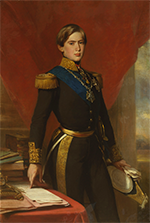King Pedro V of Portugal
Pedro V was King of Portugal was eight years in the mid-19th Century. He was a very popular king who oversaw the early modernization of his country. He was born on Sept. 16, 1837, at Necessidades Palace in Lisbon. His mother was the reigning monarch, Queen Maria II, and his father was Ferdinand of Saxe-Coburg and Gotha. Pedro was his parents' oldest son and so was the heir apparent. As such, he benefited from extensive training, showing skill in languages (speaking Latin fluently), philosophy, and sciences. 
Queen Maria II died, during childbirth, when Pedro was 16. He took the throne, with his father as regent, and worked hard to help the people of his realm. Embracing modernization, he encouraged the construction of railways and roads and the use of the telegraph and the metric system. He championed advancements in public health and visited many hospitals during a cholera outbreak, comforting the ill and handing out gifts. A keen student, he encouraged the people of Portugal to extend their learning throughout their lives and had built new schools at which students could access Portuguese translations of the latest scientific discoveries. He also took an assumed name in writing articles on current events for a few publications. Not much for ceremony, Pedro refused to have his subjects kiss his ring or kneel or bow to him. Always one for good ideas, he had a suggestion box installed in the palace and read and responded himself to messages placed therein. Significantly, in 1854, he also abolished slavery, which for many years powered the overseas economy. In the international arena, Pedro in 1855 signed a pact with the United States to install an underwater cable connecting the two countries and in 1860 approved a trade treaty with Japan. In 1858, Pedro married Princess Stephanie of Hohenzollern-Sigmaringen. She died a year later, of diphtheria, and he founded a hospital in her name. The couple had no children. Pedro himself succumbed to a dread disease, typhoid fever, in 1861. He was 24. His younger brothers Fernando João also died. His remaining brother, Luís, succeeded Pedro on the throne, becoming King Luís I.
|
|
Social Studies for Kids
copyright 2002–2025
David White




